Activities
This history includes Guglielmo Marconi’s experiments, Titanic’s SOS message (picked up by few vessels), the birth of radio and television, Sputnik’s launch into orbit by the Soviet Union, the live moon landing, mobile phones (not so portable to start with…), GSM, Wi-Fi, and 5G. Also important were the first radio broadcasts and first amateur radio operators in Switzerland, the birth of SSR and RSI, the Eurovision Song Contest in Lugano, “NATEL”, Wi-Fi in Lugano, and the Swiss and Swiss-Italian satellites. The story of wireless communication consists of plenty of events and turning points that are more or less well known. By running along the wireless timeline, we will be able to enjoy a historical route among some of the events that have marked the history of wireless around the world and in Switzerland. While this history is certainly global, it also shows some local and national peculiarities. If you want to have more information on specific events, you can explore them further. The timeline is indeed “augmented,” and when you focus on some expandable areas with your smartphone, you will discover contents that are invisible to the naked eye!
Behind the panels, tubes pop out. It is our building site and is intended to highlight the material dimension of wireless, the need to service aerials or stretches of tubes through which fiber optics travel, carrying sections of wireless signals. It is intended to serve as a reminder of the square kilometers taken up by server farms with scores of servers humming and consuming energy, but which store our personal data in the cloud. It makes us think again of all the devices produced and sold because of wireless, devices that often age rapidly, which require frequent replacements, and add to the amount of digital waste that is also caused by wireless. In conclusion, there can be no wireless without its material side!
How to see augmented contents?
1. Install the Artivive app
Timeline: global and local milestones
Scroll through the dates and discover the history of wireless.
With Internet Explorer the timeline isn’t visible, please use another browser.
-

The first wireless transmission by Guglielmo Marconi
Guglielmo Marconi. Source: The Guglielmo Marconi Foundation and Museum, Pontecchio Marconi.In 1895, Guglielmo Marconi managed to send a telegraph message, without the use of wires, from the window of his home in Pontecchio (Bologna, Italy), which was later renamed Pontecchio Marconi. This experiment marked the beginning of a new era of communication: nation states, entrepreneurs, and inventors challenged each other to take control of wireless, while a considerable number of amateur radio operators exchanged messages in Morse code, a binary code made up of sequences of dots and dashes.
AR: Villa Griffone, where Marconi lived and made his first experiments with wireless.
-
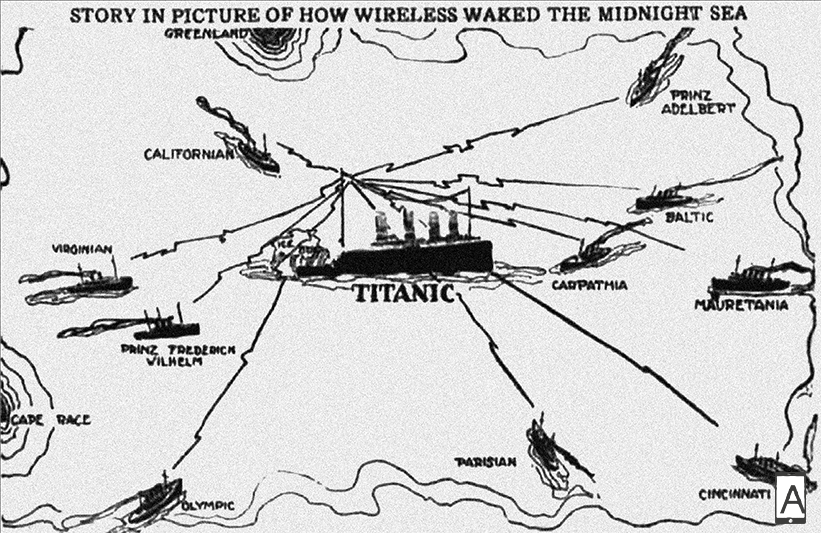
The sinking of the Titanic and its unheeded SOS messages
A reconstruction of the SOS distress signal sent by the Titanic to surrounding vessels, 1912. Source: Story in picture of how wireless waked the midnight sea, 17 aprile 1912. The day book, p. 6.The transatlantic liner Titanic struck an iceberg between April 14 and 15, 1912, and slowly sank. This story, which has become so familiar, partly thanks to a 1997 Oscar-winning film by James Cameron, also involved wireless communication. Most of the ships at sea near the Titanic were not equipped with wireless telegraph devices and were, therefore, unable to receive its SOS message. However, after the sinking, a new international regulation required all passenger ships to be equipped with wireless devices.
AR: Last messages of Titanic sent by wireless in Morse code.
-
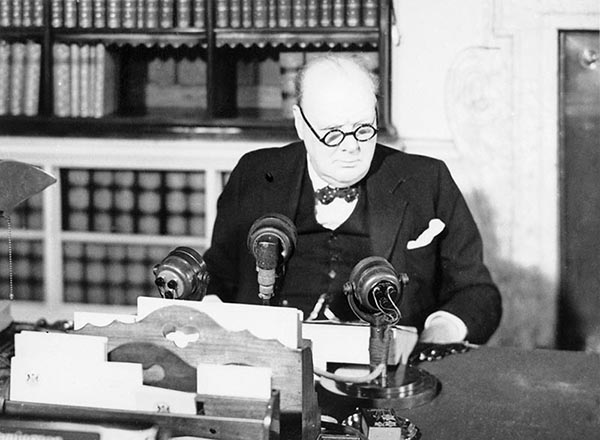
The BBC is founded (and radio broadcasting booms)
Winston Churchill at the BBC microphone broadcasts to the nation a discourse during "Victory in Europe Day", 8 May 1945. Source: Wikipedia Commons.In the 1920s, the first radio stations were opened, foreseeing the use of wireless as distinct from that of Marconi: Instead of private communications between people using the Morse code, radio broadcasting offered spoken and music programs addressed to a listening audience. The British Broadcasting Company (BBC) was one of the first and best known public radio stations in Europe. Set up in London in 1922, and initially led by John Reith, the BBC offered the audience a schedule comprised of information, education, and entertainment programs. Nowadays, the BBC continues to be regarded as a benchmark for public service broadcasting worldwide.
-

The first Swiss radio broadcast
Control console in the first Swiss radio studio at Lausanne Champ-de-l’Air, 1922. Source: Museum of Communication, Bern.The first Swiss radio broadcast took place in Lausanne in 1922 using the Champ-de-l’Air transmitter, when it was not in use for ordinary air traffic. In 1923, two further transmitters were put into operation near Geneva and Kloten, and more radio stations gradually developed around the country. During the 1920s, Switzerland did not have a centralized radio broadcasting service, but different local radio stations sprang up.
-
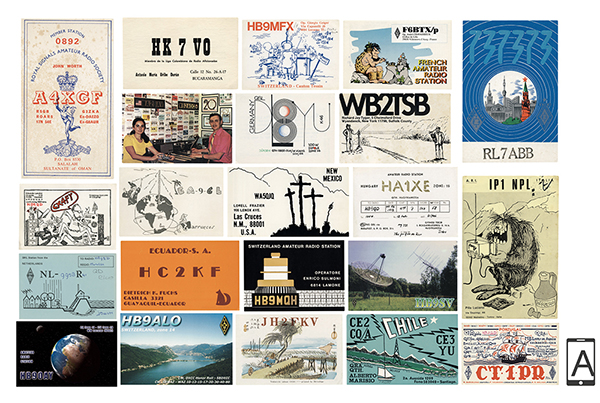
The first radio amateurs’ clubs in Italian-speaking Switzerland
QSL-cards received or sent by a few radioamateurs in Ticino. Source: Radio Museum, Monte Ceneri.Having spent decades experimenting, Swiss radio amateurs began to gather in associations and clubs at the end of the 1920s. In Locarno, radio amateurs set up a club in 1929, followed by those in Lugano in 1932. There are now around 350 radio amateur operators in Ticino, who have passed a federal exam. Their activity ranges from listening to radio signals, wireless experimentation, and the construction of transmitting and receiving devices. Perhaps their most intense activity is the exchange of messages, with its own peculiarity. Having made contact on the waves, amateur radio operators actually send each other printed cards, on which they note technical specifications and special codes. These cards are personal (each operator has his/her call sign) and are known as QSL-cards, which means “acknowledge receipt.”
AR: The back of QSL-cards.
-

Società svizzera di radiodiffusione (SSR) is founded on February 24
Nini Mousny the first RSI announcer, 1933. Source: RSI Archives, Lugano.The Società svizzera di radiodiffusione (SSR) was founded on February 24, 1931, and for the first two years, only broadcast programs in German and French, which were listened to in the Italian-speaking part, thanks to wired broadcasting. The first Italian-language programs began to be experimented with in 1932, and on April 18, 1933, the Monte Ceneri medium waves national transmitter began operations, the third in Switzerland after those of Sotten and Beromünster. This transmitter broadcast its programs via airwaves. The year 1933 therefore saw the real establishment of Radio della Svizzera italiana (RSI). The RSI acronym was initially amended to RTSI with the advent of television, but RSI was reintroduced in the last few years to mean “Radiotelevisione svizzera di lingua italiana, Swiss-Italian radio and television.”
-

The invention of the walkie-talkie
Walkie-talkie for communicating on the top of mountains. Source: Pixabay.Walkie-talkies can be seen as the predecessors of the modern cell phone, as they are two-directional, portable transmitters and receivers. Invented by Donald Hings in 1937, walkie-talkies spread in large US cities, especially for communication among police or armed forces on battlefields. They are still in use today, in a more developed version, for communication between trucks (the so-called CB), in areas with no telephone coverage (i.e., up mountains), or among children as toys.
AR: Walkie-talkies in the movie "Ghostbusters" (1984).
-

Television is introduced at the New York World’s Fair
Television in the movie theaters in Italy, 1950s. Source: Wikipedia commons.The term tele-vision began circulating right from the beginning of the 20th century. The first experiments with television took place in a number of countries—e.g., England, Germany, the United States, France, Italy, and Japan—between the 1920s and 1930s. World War II, however, brought an end to the pre-historic phase of TV, which was actually reborn after 1945 and rapidly spread in the 1950s until it became the most powerful mass medium in the second half of the 20th century. One of the best-known moments in the pre-history of TV was its presentation at the New York World’s Fair. David Sarnoff, then president of the well-known Radio Corporation of America (RCA) and the man who first intercepted Titanic’s SOS, gave a long speech on the potential of TV.
AR: Listen to David Sarnoff’s voice introducing TV at the New York World Fair, 1939.
-

The first Eurovision Song Contest takes place in Lugano
A moment of Eurovision 1956 from the Kursaal Theatre in Lugano. Source: RSI Archives, Lugano.The first Eurovision Song Contest took place at Teatro Kursaal (now home to Casino) in Lugano in 1956 and was organized by the European Broadcasting Union. Seven countries participated, and the Swiss singer Lys Assia won the first prize. In order to broadcast this event across Europe, many radio and TV infrastructures had to be implemented and boosted, the main one in the Italian-speaking part of Switzerland being the radio link on Monte Generoso.
AR: The winner of first edition, Swiss Lys Assia, sings "Refrain".
-
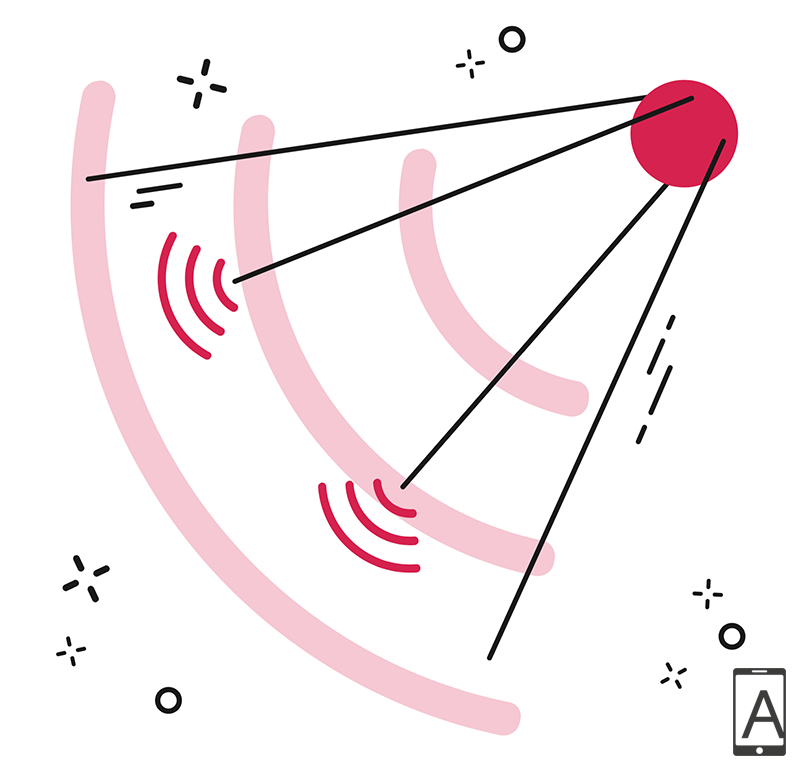
Sputnik’s launch: The first artificial satellite
Sputnik 1 replica. Source: Laboratory of Visual Culture, SUPSI, Canobbio.In 1957, the Soviet Union launched the first artificial satellite into orbit around the Earth: Sputnik. This satellite came with four antennas to broadcast radio pulses that could easily be picked up by amateur radio operators. Its launch was symbolic, especially as it happened during the Cold War. The United States understood the extent of the USSR’s technological advances and gave way to a new development program, which led to ARPANET, the precursor to the current Internet. Satellites then went to join other wireless technologies and are still essential today in TV broadcasting, mobile communication, and Internet data exchanges.
AR: Soviet TV announcing the news of Sputnik launch: "On October 4, 1957, the conquest of the universe began".
-

Televisione svizzera di lingua italiana (TSI, Italian-speaking Swiss TV) begins broadcasting from Paradiso
The interior of a TV shooting cart used for outdoor shots. Source: Technische Mitteilungen PTT, Radio Museum, Monte Ceneri.After years of experiments, SSR began regular TV broadcasting from Zurich and Geneva in 1958, also offering programs in Italian that could be picked up, with some difficulty, in the Italian-speaking part of Switzerland. These were offered alongside RAI’s (Radiotelevisione italiana, Italian public service broadcaster) programs. RAI had begun broadcasting in 1954, and its programs were also followed by large audiences in Switzerland. The initial TV productions in the Italian-speaking part of Switzerland only got underway in 1961. To start with, the TSI studio was located at the former tram depot in Paradiso, but in 1962, production relocated to the new radio studio in Lugano Besso. The site where the TV studios are still located, Comano, was inaugurated in the 1970s.
AR: Kids singing during the opening of the new television centre on Monte San Salvatore, 1958.
-

Moon landing live on television
Marco Blaser and Eugenio Bigatto commenting on the moon landing during the 1969 RTSI live broadcast. Source: RSI Archives, Lugano.On 20th July 1969, Neil Armstrong and Buzz Aldrin were the first humans to walk on the moon and were watched and heard (including the familiar phrase “That’s one small step for man, one giant leap for mankind”) by around 600 million people on live television. To organize this live worldwide show, the signal was broadcast to three stations on Earth located in Australia, California, and Spain.
AR: RSI live show on the moon landing.
-

“NATEL”, the forerunner of the cell phone, is marketed
Advertising of Natel Commander C, 1988. Source: Technische Mitteilungen PTT, Radio Museum, Monte Ceneri.NATEL (Nationales Auto-TELefonnetz, National Car Phone Network) was the first Swiss mobile phone network. It opened in 1975 and was marketed from 1978. The first NATEL phones were fitted inside cars (hence the name) and in custom-built portable cases so that calls could be made on the go. Natel A’s success was soon followed by the introduction of Natel B in 1983, Natel C in 1987, and Natel D in 1992. NATEL became so popular that, even today, it is being used as a synonym for mobile phones (e.g., “may I have your NATEL number?”).
AR: Interview with Xenia Tchoumitcheva, 11 years old, on the ways she used NATEL, 1998.
-

First cell phone network opens to the public
The mobile phone today on Tokyo’s subway. Source: Pixabay.The first cell phone network, which was accessible to every subscriber, was launched in Japan, in the Tokyo metropolitan area, in 1979 and, from 1984, in the rest of the country. The idea of dividing the land in various “cells” (hence cellular telephony) within which telephones would communicate with base stations first emerged back in the 1940s. However, it was not until the 1980s that millions of people started to use mobile telephony to communicate while on the move. Nowadays, there are more mobile phones than people on planet Earth.
AR: Japanese Sketch Comedy on Mobile Phones' obsession, 1980s.
-

The GSM standard is adopted by 8 European countries
Source: Laboratory of Visual Culture, SUPSI, Canobbio.In December 1992, a sort of European “bureaucratic miracle” took place. From that date onwards, Denmark, Finland, France, Germany, Great Britain, Italy, Portugal, and Sweden decided to adopt a common standard of mobile telephony: the Global System for Mobile Communications (GSM). GSM is now in use almost everywhere in the world. It allows people to use their own mobile phones in any country, thereby making global communication easier. Thanks to GSM, mobile telephony expanded rapidly and, in the 1990s, some European companies such as Nokia and Ericsson became symbolic for a whole generation.
AR: Neo uses a Nokia mobile phone in "The Matrix" (1999).
-

The IEEE 802.11 standard, better known as Wi-Fi, is released
Source: Laboratory of Visual Culture, SUPSI, Canobbio.In the 1980s and 1990s, a number of wireless technologies were developed to facilitate communication between computers and various devices, e.g., Token-Ring, WaveLAN, etc. The most famous among these was probably the Wi-Fi, based on the IEEE 802.11 standard, released in 1997. The name Wi-Fi was coined as a pun on Hi-Fi (high fidelity), a generic term used to indicate high-quality audio technologies. Contrary to common belief, Wi-Fi is not an acronym for wireless fidelity, but only the result of a skillful marketing move.
AR: Steve Jobs introduces the Wi-Fi using a hula hoop to assure people that there is no wire, 1999.
-

A free Wi-Fi network opens in Lugano and, in 2011, in Locarno.
Network coverage area for Wi-Fi Lugano. Source: Laboratory of Visual Culture, SUPSI, Canobbio.Lugano was one of the first Swiss cities to implement a free Wi-Fi network in April 2008, and since then, it has constantly been improved and extended. This project was supported by a number of local stakeholders: the main electricity company (AIL), the City of Lugano, the casino, and Lugano Turismo (Tourist Board). In 2011, Locarno implemented a similar project with the first experimental Wi-Fi aerials in Piazza Grande.
-

Switzerland launches its first satellite into orbit: SwissCube
The Swiss Cube satellite. Source: EPFL’s Space Center, Lausanne.The first Swiss satellite, a 10 cm by 10 cm cube, was launched into orbit on September 23, 2009. Appropriately called SwissCube, it was meant to last between three months and one year, but it is still orbiting the Earth almost ten years later. In July 2010, SUPSI, too, launched into space its own satellite developed by students, the TIsat-1 (TI stands for Ticino).
-
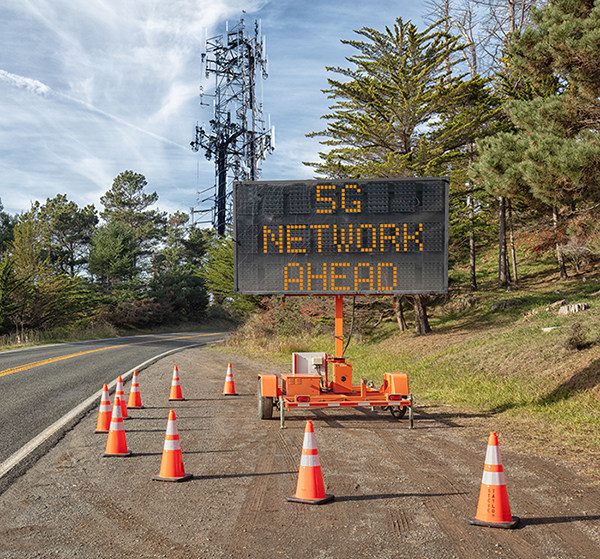
The 5G standard is defined: It will mark the future of wireless
Source: iStock.The abbreviation 5G indicates a new generation of mobile communication that enables objects to communicate among themselves (implementing the so-called “internet of things”). Soon, the fridge will be able to tell the smartphone that it’s empty! With this latest-generation mobile communication, which Switzerland tested early on, data will travel more quickly. For example, the same data that can be downloaded with 4G in six minutes will be downloaded with 5G in three seconds.
-

One of the two aerial mast on Monte Ceneri is demolished
Monte Ceneri's antenna. Photo: Valentina Meldi.In 2016, the medium-wave broadcasting aerial masts on Monte Ceneri was demolished. The aerial mast built in 1933 is still in operation today, but for other services. Monte Ceneri has been so popular in the history of local wireless that in the 1930s, RSI was nicknamed Radio Monteceneri.
AR: The helicopter takes down one of the two Monte Ceneri's antennas in 2016.
-

Date set for the launch of 5G technology across Switzerland
Source: Laboratory of Visual Culture, SUPSI, Canobbio.In 2020, Switzerland will launch 5G, in line with the “Digital Switzerland” strategy adopted by the Federal Council. Swiss mobile operators are currently working on expanding 5G alongside a number of network device providers. To extend their activities to 5G, all mobile phone operators bought new frequencies from the Federal Communication Commission during a public auction. To recover the cost of 380 million Swiss Francs, Swiss telecommunication companies will hold a 15-year license on these frequencies.
No Wi-Fi zone
Are we still capable of spending a few minutes without wireless, with no connection for our smartphone, no Wi-Fi networks for our computers, unable to make a call, send messages, or surf the web? This installation is intended to make us think about the absence of wireless in daily life. Sitting on our Wi-Fi-free bench, and enter a space without connection. What will you do in the meantime? What will you miss most from your online life? With which activities will you replace the use of wireless? At the same time, think of how wireless has now become part of your daily life — how we take it for granted because we do not see it — but as soon as it does not work, you realize how important it is. The No Wi-Fi zone is an experience intended to both claim back offlineand wireless-free time and to have us reflect on our daily life experienced “naturally” online, thanks to wireless technologies.
Radio time machine
23.07 – 24.07.2019, Darsena, Parco Ciani, Lugano
Borrow our wireless headphones, and take a step back in time. Listen to the radio programs we have found in the RSI Archives, and relive styles, genres, and events from the past!
Silent Disco
31.07 – 17.08.2019, Rotonda, Piazza Castello, Locarno
Dance with us! Wear the wireless headphones, and step into disco mood. Every now and again, take them off, and enjoy watching others dance “music-free.” Wireless technology coordinates silently! The event is organize by laRotonda and sponsored by Swisscom.
LaFilanda, Mendrisio
29.08 – 02.10.2020
In the square in front of LaFilanda, the timeline with some of the key events in the history of “wireless” will be visible for the first time in Mendrisio. After Lugano and Locarno, then, the project continues its dissemination path also in Mendrisio, where SUPSI will inaugurate the new campus of the Department for Environment Constructions and Design in September 2020. LaFilanda’s vision goes hand-to-hand with #DecodingWireless: in fact, LaFilanda promotes meetings, exchanges, creation of bonds among people, offering a multiplicity of services and activities to spend free time. The timeline will also be a way to draw attention to the “World Telecommunication and Information Society Day” scheduled for May 17.Understanding wireless, history and omnipresence in everyday life
11.09.2020
Conference 6:00 – 7:00 p.m.
Speaker Prof. dr. Gabriele Balbi
Look at the flyer!
USI Campus, Lugano
25.02 – 19.05.2020
From February 25 to May 19, the interactive timeline with some of the key events in the history of “wireless” will be available at the main USI campus in Lugano. Located in front of the entrance to the lecture hall and between the building of Informatics and the main building, the timeline can be visited 24 hours a day by all interested parties and, in particular, by the students. The project, in collaboration between USI and SUPSI, in 2019 was intended for the general public during the LongLake Festival and the Digital Day in Lugano and the Locarno Film Festival. Now, it reopens in 2020 by addressing students. In fact, you do not learn just in the classroom, but this installation aims to stimulate minds, play with the past, and wonder about the present of wireless even outside. The timeline will be also involved in the open day taking place at USI campus on 25 April 2020.



